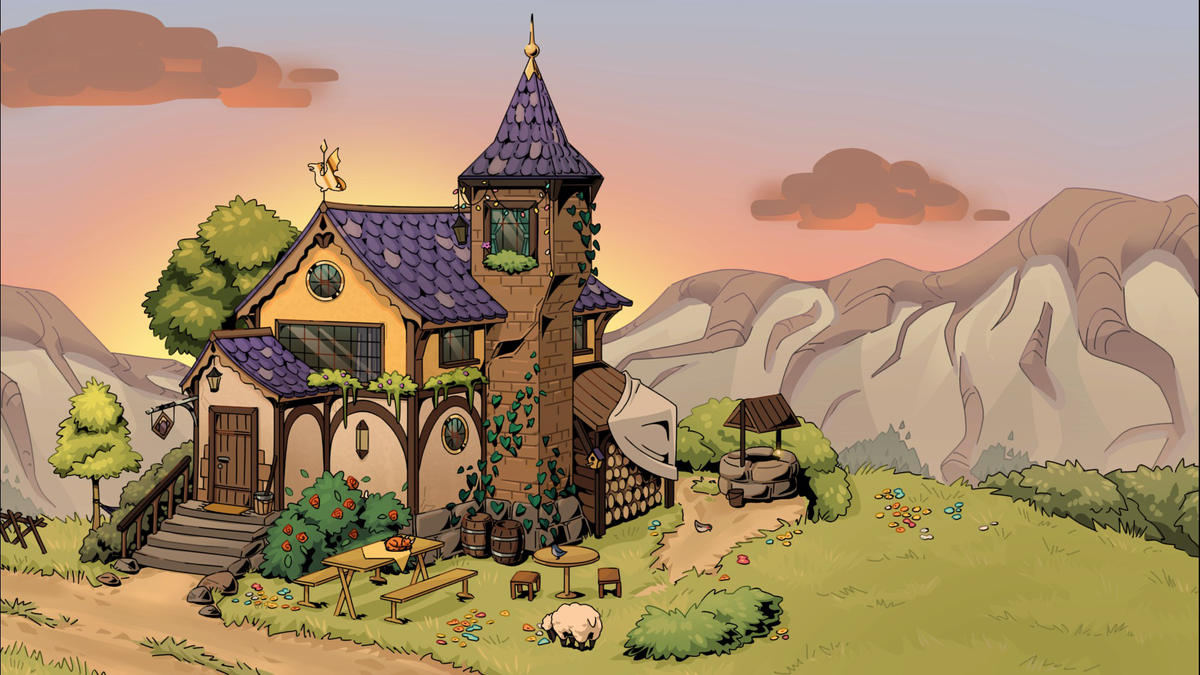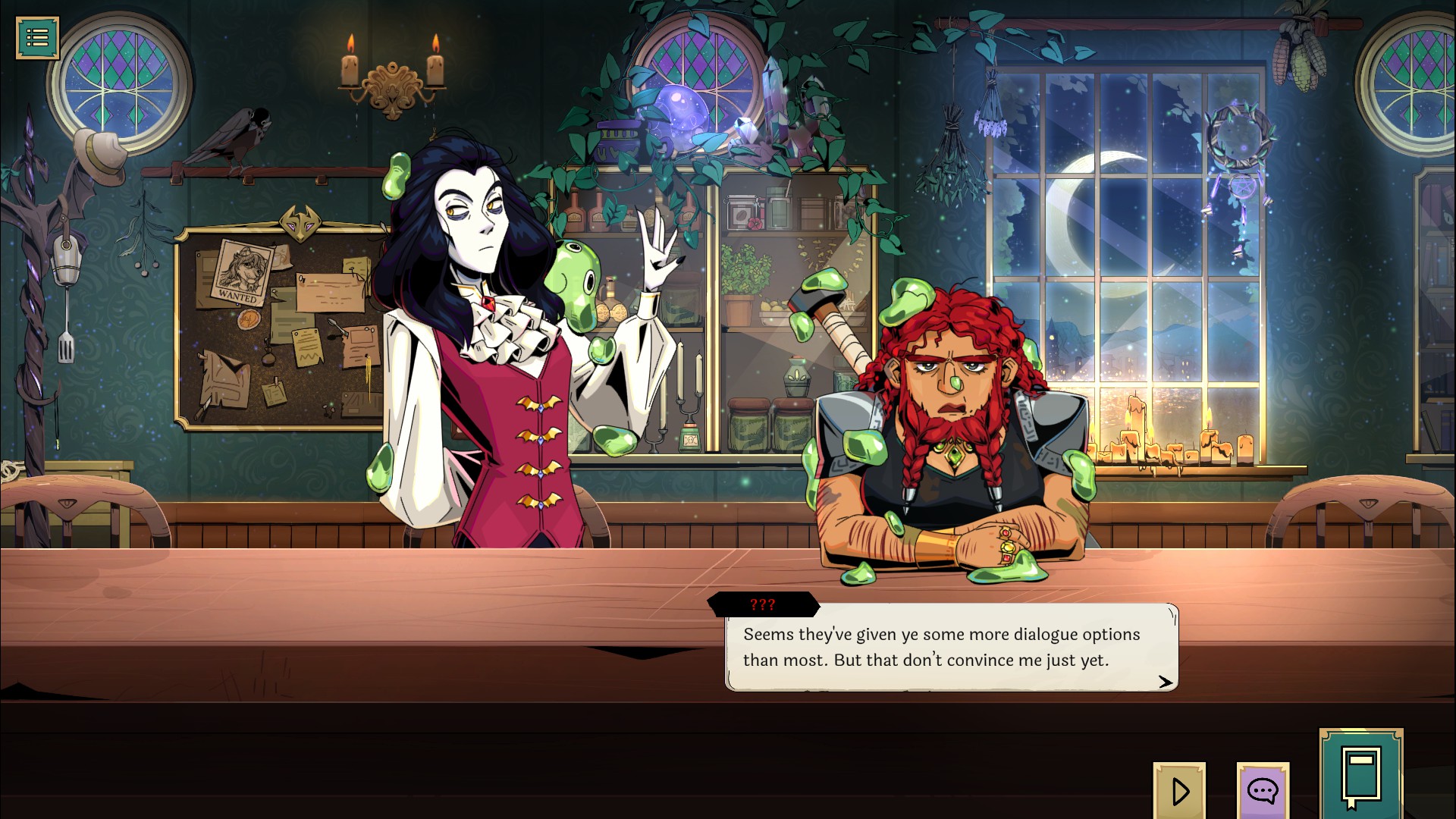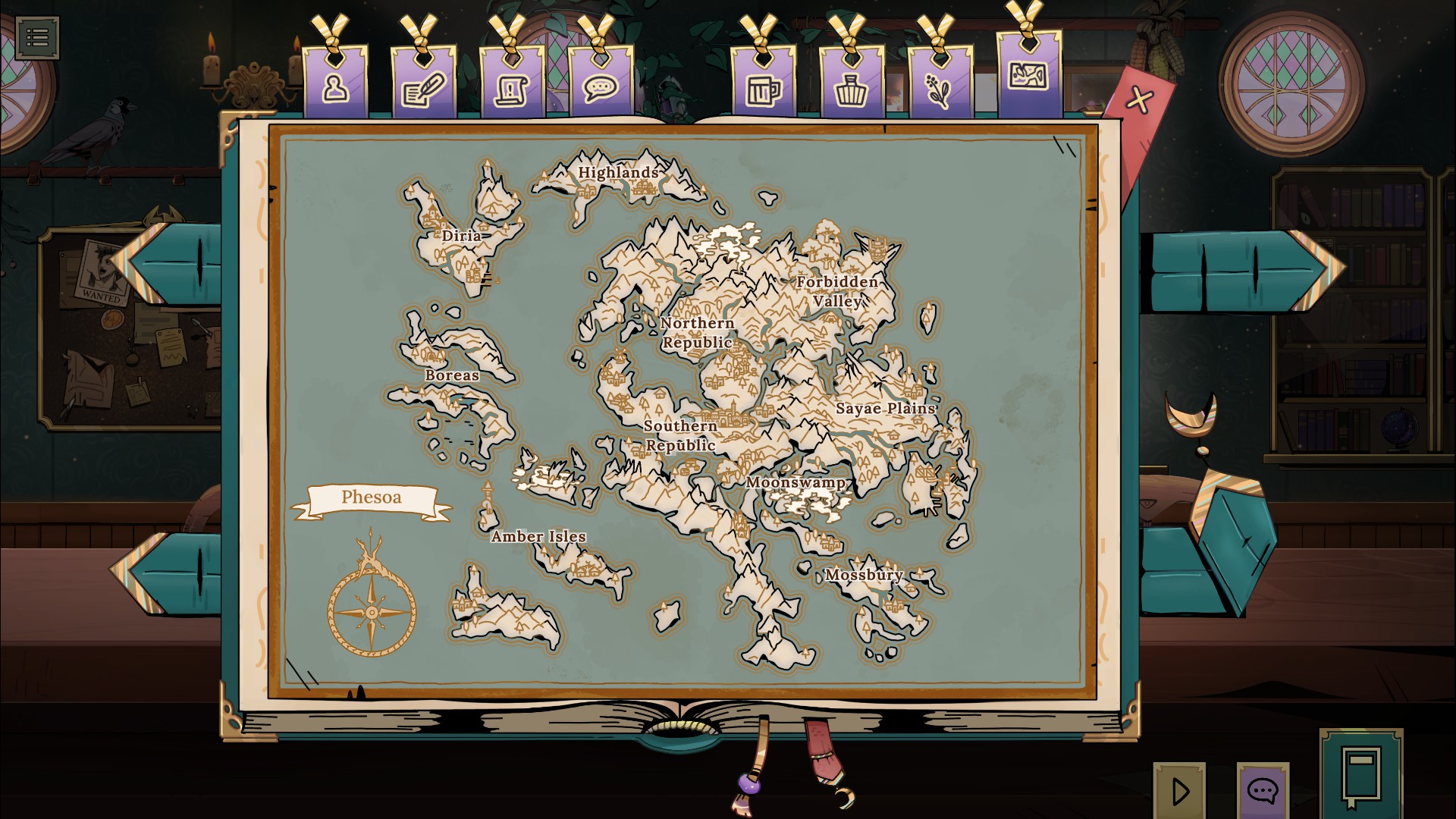
In recent years there has been a progressing appearance of the cozy drinking simulator, popularized by 2020’s Coffee Talk, followed by 2022’s VA-11 Hall-A, and now 2024’s Tavern Talk. Each game typically follows the same formula: an intimate setting—a coffee shop, futuristic bar, or run-down tavern, respectively—wherein our character serves drinks in exchange for the visitor’s story or troubles. I’m going to refer to the cast as ‘visitors’ as I don’t actually think anyone ever paid me for my services. This flows into a game that allows for overarching narratives and character studies that we as players weigh in upon, trying to provide an unbiased, helpful perspective. However, what stood out to me in Tavern Talk’s case is its long run-time; it is almost like the genre is evolving in how their length started from 5 hours to 10 and now to 15. This is definitely in its favor, as it allows for more wiggle room to explore your customer’s needs and histories and to play around with new mechanics and systems, highlighting its ambition in standing out in its genre.
Tavern Talk is a fantasy visual novel that follows the adventures of your many visitors in the land of Asteria. As usual of the genre, you bear witness to their troubles and offer them respite in your catalog of drinks. To my delight, this cast of fantastical beings is rich with variety without any of the main cast lacking substantial development or relevance. The devs even treat players with cameos from other games, such as Polly and Scott from Monster Prom and Minthie and Quincey from the Lucky Gryphon. I didn’t realize these references until I looked into the Kickstarter page, so treat these characters as fun one-off episodes rather than integral to the overarching story. Other characters range from the typical Elf and Vampire to the more unique Echo and Seraph. However, despite their different backgrounds and beliefs, friendships are built and parties are formed, culminating in a united cast that bounces off each other in comedic and heartwarming ways. You can even play matchmaker! Watching as love blooms between unlikely individuals. Another enriching aspect of this cast is the commitment to representation and inclusivity, which should be praised for how seamlessly it is implemented. Pronouns are always listed in each character’s logs, and Minthie’s disability is visible in the form of two good doggos and discussed in relevance to her career as a writer.
Each character has their own respective arc, and watching these unfold regarding the quests they accept and complete is quite rewarding. For example, the air echo Zephir starts the narrative as emotionally detached and secretive in their history, the typical rogue character. However, as they take on more quests with other party members, they slowly open up and begin to care for their companions, subsequently forming bonds with them and working through their trauma. However, one arguable fault with this cast and their stories is its simplicity and reliance on stereotypes. Tavern Talk indulges in its D&D inspiration, often allocating characters to their relevant stereotype. Kyle the vampire is gaudy, Rhea the dwarf is hard-headed and standoffish, and Clay the half giant is soft-hearted and peaceful. If you are a fan of the genre, you will probably roll your eyes at these obvious tropes, but in my experience with the game, I don’t think this is technically a bad thing or takes you out of the experience. The game boasts tongue-in-cheek humor, with regular 4th wall breaks poking fun at its age rating and directly acknowledging statistics and proficiencies like strength or defense, which are boosted by its stereotypes. It also works well with a beginner audience in mind, making it more accessible for those with a lack of D&D knowledge. Although, if they were to make a sequel, more nuance would be welcomed.
A big surprise for my first playthrough was the involvement of the Tavern keeper, the player’s stand-in, as they surprisingly play an involved role, not just as an unbiased listener. As the narrative develops, there is a lurking mystery in who you are as visitors are revealed to be old friends and a mysterious letter is passed to you that you can’t bring yourself to open. This begins a character arc that doesn’t shy away from your character’s flaws and raises questions if you have the right to dole out advice or steer customers towards certain drink options that have direct effects on their quests. The overarching narrative culminates in these questions as you find yourself entangled in the consequences, but sadly, it doesn’t pay off too well. The villain of the narrative is out to destroy the world, and the game does the build-up well enough, providing consequences for your actions and risks. However, due to being chained to your tavern, the big final battle feels lackluster and ends quite abruptly for everything it was trying to hype the player up for.
The worldbuilding of Tavern Talk is nothing short of amazing in how detailed and committed it is to its universe’s laws and history. Within your logbook, you are provided with reams of information; most impressive is its expansive map with geography and locations described in full detail. In the spirit of D&D, it does wonders in making the world feel realized in its adventure and danger. This pairs with its rich use of mythology, from the gods Leviathan and Cassiopeia to its minor creatures like the Banshee and Mari-Morgan. As a mythology buff, I found great pleasure in how they were used, like little Easter eggs. Especially the Mari-morgan, who I spotted straight away as a resident of Welsh mythology—I love you and thank you, devs. There is a lot to tuck into within Tavern Talk, as the world is crafted alongside the progression of the narrative, gripping the player from start to finish with its multiple layers to explore if the player wants to indulge.
Its world and history are accompanied by a gorgeous art style, subsequently capturing the fantastical feeling of the realm of magic and adventure. Of course, you spend 99% of the time in your tavern, but this singular location is broken up by differences in weather, from cozy stormy nights to the early dawn. Linked to the story are also events that see the outside of your tavern flooded and falling stars, which sounds more aesthetically pleasing than it is in practice. It’s these little changes that break up the monotony and add tone and atmosphere to the game. The inside of your environment also slightly changes in the form of trinkets brought back by your customers; a vampire clock is exactly what the place needed to up its gothic aesthetic, thanks Zephir. Each character also has their own fun and vibrantly colored design, ranging across different body types that are easily distinguished; I just kept wanting more and more characters to pop up!
The main gameplay feature of Tavern Talk is its drink-making system with 15 different recipes to choose from and a fusion system that adds a dash of variety. The game’s use of drinks differs from its predecessors in its capability to shape the narrative and ability to make different combos. It stands out in comparison to Coffee Talk’s three-ingredient guessing game (which can act as a frustrating element due to not knowing how to make a certain drink) as you are given a recipe to replicate. The mixing system includes a sectioned jug that you pour your liquids into, a simple pouring mechanic that is substantial enough, and if you make a mistake, you can use your handy dragon companion Andu as a bin to reset, good boy? With each ingredient you pour in, your chart will then fill up toward the desired skill, and upon success, it will allow you to hand out your drink.
At the start of the game, you are given 6 beverages that are allocated to buffs found in classic D&D: agility, intelligence, strength, defense, and charisma, which often relate to what skills the customer wants to boost. This works greatly on a surface level, as the drinks act as a representative of their character. Fable, a nervous and inexperienced adventurer tends to stick to agility-style drinks to remain undetected or get out of a perilous situation. Meanwhile, Caerlin is a confident giant sword wielder who would prefer a more hands-on approach, therefore asking for strength-based drinks. However, this often entails that customers will stick to their singular preference of beverage, which can become monotonous in practice. In the first half of the game, you begin to turn your brain off when making drinks, as you’ve made them many times before without much wiggle room. However, to combat this, the game does update your mixology with other drinks throughout the game that fall under the same stat boosts. Frosted Lagoon is the default defense boost drink, but you’ll later gain Steel Tonic to mix it up (pun intended) but still gain the same overall statistic.
Another cool addition is the use of fusions, ingredients that add bonus points to each stat and offer a unique skill—which is relevant to the quest system—from Draconic Light to Invisibility. These can also break up the monotony of mixing the same drinks but aren’t used nearly as much as I had hoped. Some are only relevant to a singular quest, never to be seen again. It’s instead up to the player to think outside the box and try different combinations to achieve the same effect as if you made the drink normally. Overall, the system is varied but leaves a bit of room for improvement. To the developer’s credit, their roadmap for updates includes more drink variety and an attack on the repetitive Swift Strike, so I’m looking forward to a bit of refinement!
Finally, and wholly unique to Tavern Talk is the quest system that separates it as not just a cozy drinking sim but as a fun piece of D&D media. During your many conversations with the game’s characters, they will pick up on rumors from their experiences and interactions. These appear as notes in your journal that may seem disjointed to begin with but will flesh out to become more coherent as you progress the game. Once you have gathered enough bits of information, at the end of the game day you will be given the option to piece together three relevant notes that will form into quests. Once these quests are formed, you can plaster them on your tavern’s quest board for different characters to take. This allows for interesting character interactions and fun stories to hear about once they have returned, expanding the scope of the game’s world to feel lived in and not isolated to a single conflict. This system melds well with the drinks mechanic, as what drinks you give to the character taking on the quest will give you one of two outcomes. For example, Melli may ask for an agility drink with invisibility to sneak around her enemy, while another option may be a charisma drink with popularity so she can talk her way out of the situation. This grants the player minimal player choice that is enough to feel impactful and appreciated in its involvement, but be careful; the game separates these outcomes into successes and failures, which will narrow your narrative path to a good or bad ending, upping the stakes of your involvement in your friends’ lives.
Tavern Talk
Great
Tavern Talk is definitely the best next step in a line of cozy drinking talking simulators, as it tells a charming and gripping narrative that echoes the adventures found in the realm of magic and fantasy. It stands out on its own as a fun and heartwarming piece of D&D with its unique cast of characters and vast world-building and pairs well with great gameplay systems that add depth to its world but could use a bit of beefing up to break up the monotony.
Pros
- Interesting varied cast
- A quest system that adds that D&D flare
- Expansive and magical world-building
Cons
- Abrupt story ending
- A lack of drink variety and use of fusions
- Lack of nuance in a stereotype-focused cast




